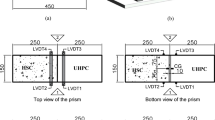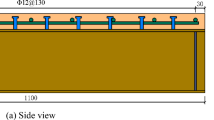Abstract
This paper deals with research undertaken at Oxford Brookes University into shear strengthening of reinforced concrete beams using externally bonded carbon fibre reinforced plastic plates (CFRP). Thirty-eight reinforced concrete beams of 1.8 m length were constructed and tested and are described in this paper. The relative performance of a group of sixteen beams with the same steel reinforcement but with different amounts of shear strengthening is discussed. All the beams were designed to fail in shear using a spreadsheet program. The spreadsheets were designed to ensure that the beams' flexural capacity exceeded the shear capacity after strengthening. The variables were: main reinforcement ratio, spacing between links in the shear span and different configurations of CFRP plates on shear spans. The concrete had an average compressive strength of 61.76 N/mm2. The majority of the beams tested showed a significant improvement in shear strength by the addition of CFRP plates, with increases of between 19–122% over the control beams.
Résumé
Cette étude entreprise à l'Université d'Oxford Brookes traite de la recherche sur la résistance au cisaillement de poutres en béton armé renforcées par collage externe d'un doublage plastique armé de fibres de carbone (CFRP). Trente-huit poutres de béton armé de 1,8 m de longueur furent construites et testées: elles sont décrites dans cette étude. La performance relative d'un groupe de seize poutres avec le même renforcement d'acier mais avec des capacités différentes de résistance au cisaillement est discutée. Toutes les poutres furent conçues pour s'affaisser au cisaillement suivant un programme préétabli. Le programme était conçu pour s'assurer que la capacité de flexibilité des poutres dépassait la résistance au cisaillement après armement. Les variables étaient: la proportion du renfort principal, l'espacement des protées et les différentes configurations du doublage CFRP suivant les portées. La résistance à l'écrasement du béton mesurée sur cube est en moyenne de 61,76 N/mm2. La majorité des poutres testées montrait une amélioration significative au cisaillement grâce à l'ajout du doublage CFRP, avec des accroissements allant entre 19 et 122% par rapport aux poutres de contrôle.
Similar content being viewed by others
References
Meier, U., Deuring, M., Meier, H. and Schwegler, G., ‘Strengthening of structures with CFRP laminates: Research and applications in Switzerland’. Reprinted from Advanced Composite Materials in Bridges and Structures, Neale, K.W. and Labossiere, P., Editors; Canadian Society for Civil Engineers (1992).
Hutchinson, A.R. and Rahimi, H., ‘Behaviour of reinforced concrete beams with externally bonded fibre-reinforced plastics’, Proc. of the 5th Int. Conf. on Structural Faults and Repair, Engineering Technics Press, Vol. 3, 1993, 221–228.
Hollaway, L.C. and Leeming, M.B. (eds.), ‘Strengthening of reinforced concrete structures using externally-bonded FRP composites in structural and civil engineering’, (1st Edition), Woodhead Publishing Ltd, (England) and CRC press LLC (United States of America) (1999).
Figueiras, J.et al. (eds), ‘Proc. of the Int. conf. on Composites in Construction’ (Porto), (Swets and Zeitlinger, 2001).
FIB Bulletin No 14, ‘Externally bonded FRP reinforcement for RC structures: Technical report on the design and use of externally bonded fibre reinforced polymer reinforcement’ prepared by task group 9.3 FRP, International Federation for structural concrete, Lausanne (2001).
Fanning, P. and Kelly, O., ‘Shear strengthening of reinforced concrete beams: an experimental study using CFRP plates’, Structural Faults and & Repair-99, Conf., London, July 1999.
Lane, J.S., Leeming, M.B. and Fashole-Luke, P.S., ‘Testing of strengthened reinforced and prestressed concrete beams’,Construction Repair (January/February 1997) 10–13.
Buyukozturk, O. and Hearing, B., ‘Failure behavior of precracked concrete retrofitted with fiber-reinforced plastic laminates’, Proc. of the 7th Int. Conf. on Structural Faults and Repair', Engineering Technics Press, Vol. 2, 1997, 21–32.
Hutchinson, R., Abdelrahman, A. and Rizkalla, S., ‘Shear strengthening using FRP sheets for a highway bridge in Manitoba, Canada’, Proc. of the 7th Int. Conf. on Structural Faults and Repair', Engineering Technics Press, Vol. 1, 1997, 263–269.
Park, R. and Paulay, T., ‘Reinforced concrete structures’, (John Wiley & Sons, New Zealand, 276–278, (1975).
BS 8110, Part I: ‘The Structural Use of Concrete’ (British Standards Institution, London, England, 1985), 3/10–3/13
ACI Committee 318-89, ‘Building Code Requirements for Reinforced Concrete (ACI 318-89)’, American Concrete Institute, Detroit, June 1990, 137–211.
Author information
Authors and Affiliations
Additional information
Editorial Note Dr. Allan Hutchinson is a RILEM Senior Member. He is the Secretary of RILEM TC 190-SBJ ‘Sercice life prediction of scaled building and construction joints’.
Rights and permissions
About this article
Cite this article
Abdel-Jaber, M.S., Walker, P.R. & Hutchinson, A.R. Shear strengthening of reinforced concrete beams using different configurations of externally bonded carbon fibre reinforced plates. Mat. Struct. 36, 291–301 (2003). https://doi.org/10.1007/BF02480868
Received:
Accepted:
Issue Date:
DOI: https://doi.org/10.1007/BF02480868




